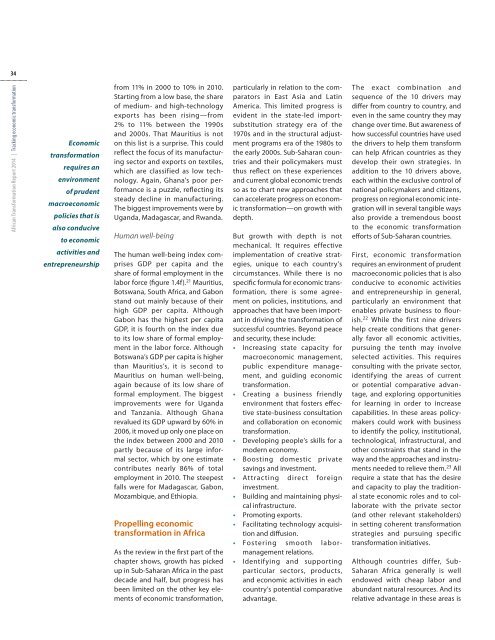2014-african-transformation-report
2014-african-transformation-report
2014-african-transformation-report
Create successful ePaper yourself
Turn your PDF publications into a flip-book with our unique Google optimized e-Paper software.
34African Transformation Report <strong>2014</strong> | Tracking economic <strong>transformation</strong>Economic<strong>transformation</strong>requires anenvironmentof prudentmacroeconomicpolicies that isalso conduciveto economicactivities andentrepreneurshipfrom 11% in 2000 to 10% in 2010.Starting from a low base, the shareof medium- and high- technologyexports has been rising—from2% to 11% between the 1990sand 2000s. That Mauritius is noton this list is a surprise. This couldreflect the focus of its manufacturingsector and exports on textiles,which are classified as low technology.Again, Ghana’s poor performanceis a puzzle, reflecting itssteady decline in manufacturing.The biggest improvements were byUganda, Madagascar, and Rwanda.Human well-beingThe human well-being index comprisesGDP per capita and theshare of formal employment in thelabor force (figure 1.4f). 21 Mauritius,Botswana, South Africa, and Gabonstand out mainly because of theirhigh GDP per capita. AlthoughGabon has the highest per capitaGDP, it is fourth on the index dueto its low share of formal employmentin the labor force. AlthoughBotswana’s GDP per capita is higherthan Mauritius’s, it is second toMauritius on human well-being,again because of its low share offormal employment. The biggestimprovements were for Ugandaand Tanzania. Although Ghanarevalued its GDP upward by 60% in2006, it moved up only one place onthe index between 2000 and 2010partly because of its large informalsector, which by one estimatecontributes nearly 86% of totalemployment in 2010. The steepestfalls were for Madagascar, Gabon,Mozambique, and Ethiopia.Propelling economic<strong>transformation</strong> in AfricaAs the review in the first part of thechapter shows, growth has pickedup in Sub- Saharan Africa in the pastdecade and half, but progress hasbeen limited on the other key elementsof economic <strong>transformation</strong>,particularly in relation to the comparatorsin East Asia and LatinAmerica. This limited progress isevident in the state-led importsubstitutionstrategy era of the1970s and in the structural adjustmentprograms era of the 1980s tothe early 2000s. Sub- Saharan countriesand their policymakers mustthus reflect on these experiencesand current global economic trendsso as to chart new approaches thatcan accelerate progress on economic<strong>transformation</strong>—on growth withdepth.But growth with depth is notmechanical. It requires effectiveimplementation of creative strategies,unique to each country’scircumstances. While there is nospecific formula for economic <strong>transformation</strong>,there is some agreementon policies, institutions, andapproaches that have been importantin driving the <strong>transformation</strong> ofsuccessful countries. Beyond peaceand security, these include:• Increasing state capacity formacroeconomic management,public expenditure management,and guiding economic<strong>transformation</strong>.• Creating a business friendlyenvironment that fosters effectivestate-business consultationand collaboration on economic<strong>transformation</strong>.• Developing people’s skills for amodern economy.• Boosting domestic privatesavings and investment.• Attracting direct foreigninvestment.• Building and maintaining physicalinfrastructure.• Promoting exports.• Facilitating technology acquisitionand diffusion.• Fostering smooth labormanagementrelations.• Identifying and supportingparticular sectors, products,and economic activities in eachcountry’s potential comparativeadvantage.The exact combination andsequence of the 10 drivers maydiffer from country to country, andeven in the same country they maychange over time. But awareness ofhow successful countries have usedthe drivers to help them transformcan help African countries as theydevelop their own strategies. Inaddition to the 10 drivers above,each within the exclusive control ofnational policymakers and citizens,progress on regional economic integrationwill in several tangible waysalso provide a tremendous boostto the economic <strong>transformation</strong>efforts of Sub- Saharan countries.First, economic <strong>transformation</strong>requires an environment of prudentmacroeconomic policies that is alsoconducive to economic activitiesand entrepreneurship in general,particularly an environment thatenables private business to flourish.22 While the first nine drivershelp create conditions that generallyfavor all economic activities,pursuing the tenth may involveselected activities. This requiresconsulting with the private sector,identifying the areas of currentor potential comparative advantage,and exploring opportunitiesfor learning in order to increasecapabilities. In these areas policymakerscould work with businessto identify the policy, institutional,technological, infrastructural, andother constraints that stand in theway and the approaches and instrumentsneeded to relieve them. 23 Allrequire a state that has the desireand capacity to play the traditionalstate economic roles and to collaboratewith the private sector(and other relevant stakeholders)in setting coherent <strong>transformation</strong>strategies and pursuing specific<strong>transformation</strong> initiatives.Although countries differ, Sub-Saharan Africa generally is wellendowed with cheap labor andabundant natural resources. And itsrelative advantage in these areas is


